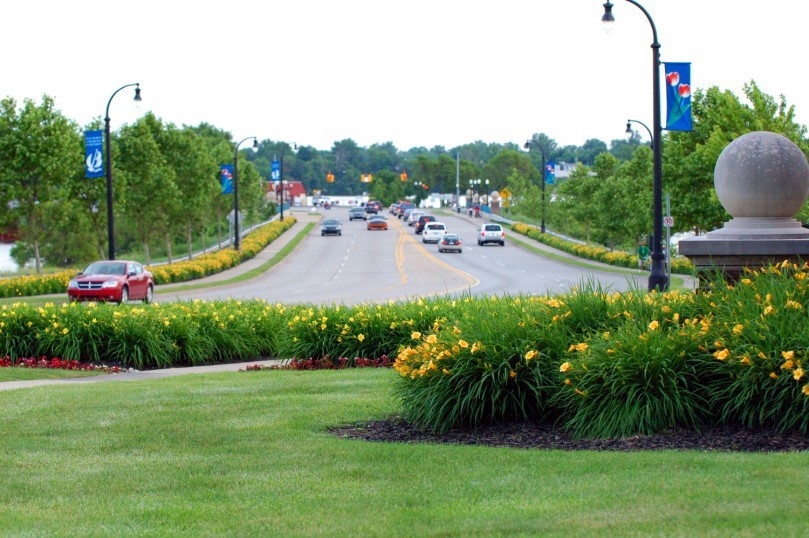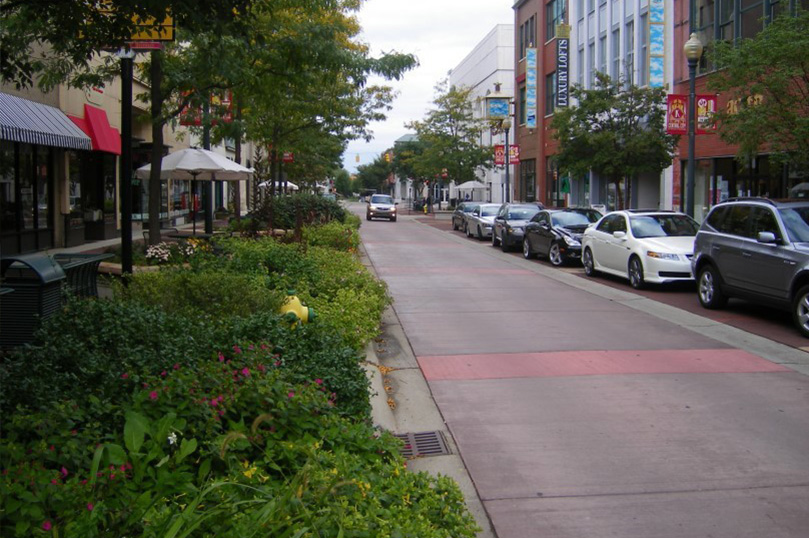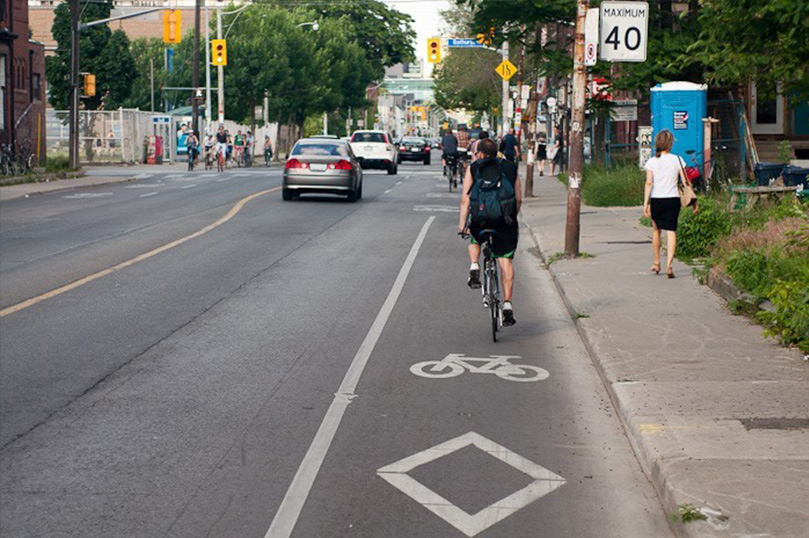Part 1 in this series (Fall 2017) discussed what makes streets congested.
A street is more than a road that carries vehicles. From driving to walking, we use streets almost every day for commuting, running errands, going to school, and for recreation. As we discussed in Part 1 of this series, our streets are often congested and not particularly enjoyable places to be. Can we improve streets to make our daily lives better?
What Makes Great Streets?
Streets can achieve a variety of community goals when thought of as more than a way to get from point “a” to point “b.” Urban designer Allan Jacobs describes “great streets” as those that “make community.” He adds that a “great street should be a most desirable place to be, to spend time, to live, to play, to work, at the same time that it markedly contributes to what a city should be.” Through improved street planning and design, we can increase mobility and access to goods and services as well as improve public health and property values. How do we achieve this?
Create “slow” streets: Vehicle speed is the number one factor contributing to the higher likelihood of deaths and serious injuries in car crashes. Slowing down vehicles makes streets safer and more comfortable places for people to be. Rather than widening streets to improve traffic flow and speeds, turn the focus onto the edges of the streets. Improving the experience of drivers can make driving on slower streets more enjoyable.
Mix land uses that work together: Creating areas that mix residential with commercial activities offers the opportunity for more diverse modes of travel. More balanced activity throughout the day offers safer spaces with more eyes on the street.
- Belleville Road between Van Buren Township and the City of Belleville
- Kalamazoo
- Royal Oak
Plan and design a Complete Streets network: Street networks should be planned with all users in mind: motorists, bicyclists, walkers, people with different abilities, transit riders, etc. Complete streets does not mean that every road has to accommodate every user. The concept is to comprehensively consider how all users of a street network can flow with excellent connectivity and ability to change modes of transportation. Consider the key destinations in the community—schools, civic buildings, neighborhoods, shopping areas, work places—and ensure the streets that connect them are safe, comfortable, and accessible for residents of all ages.
Think of streets as a component of placemaking: Placemaking is about creating memorable places for people. The non-profit organization Project for Public Spaces observes that thinking of streets as places “capitalizes on a local community’s assets, inspiration, and potential, and results in streets that contribute to people’s health, happiness, and well being.” Streets and their edges (natural and built environment adjacent to the streets) should incorporate the following:
- Street trees and plantings: Allan Jacobs observed that “trees, while not required, can do more than anything else and provide the biggest bang for the buck if you do them right. The key point again, is great streets are where pedestrians and drivers get along together.” Street trees provide shade and shelter from wind, rain, and snow. Trees soften and beautify the hard edges of the built
- Street furnishings (benches, waste receptacles), wayfinding signage, public art, and lighting (both pedestrian- and vehicular-oriented): Encourage pedestrian activity along streets by providing places to sit, things to look at, and ways to navigate. Lighting improves visibility and safety for drivers and pedestrians.
- Pedestrian-scale building design: Interesting and unique architectural details provide interest for people and create a memorable place. Include ample ground-floor windows that are well lit, colorful, and offer changing views of people
Great streets don’t just happen; great streets are the result of long-term planning that ties together land use, connectivity, and placemaking to improve community.
York v Miller: Many Medical Marijuana Ordinances Pre-empted
Under the 2008 Medical Marijuana Act (MCL 333.26421), municipalities must permit legal grow operations by licensed primary caregivers. Many communities permit primary caregivers to grow marijuana only as a home occupation. This approach may be significantly impacted by a new decision.
On January 18, 2018, the Michigan Court of Appeals upheld a trial court’s decision ruling against the Charter Township of York in a medical marijuana enforcement case. The township zoning ordinance required that any primary caregiver operation be a home occupation, defined as “An occupation or profession customarily conducted entirely within a dwelling by the persons residing within the dwelling and not more than one person who does not reside within the dwelling, and where such use is clearly incidental to the principal use of the dwelling as a residence.”
The Court of Appeals upheld the trial court’s ruling that the township zoning ordinance was in conflict with the MMMA, writing: “We conclude as the trial court did that the MMMA permits and thereby authorizes registered caregivers to grow medical marijuana for their patients both indoors and outdoors without fear of imposition of penalties by a local government. Contrary to plaintiff’s argument, the Legislature’s silence regarding authorizing the specific location of a caregiver’s right and privilege to cultivate medical marijuana may not be relied upon for the conclusion that plaintiff may prohibit caregivers from outdoor cultivation. MCL 333.26423(d) inherently provides that caregivers may elect to grow medical marijuana outdoors so long as they comply with the “enclosed, locked facility requirements.” The decision also noted that primary caregivers are not exempt from other building and construction regulations.
Planning & Zoning News from Our Communities:
Comprehensive Planning: The City of Brighton is in the midst of its Comprehensive Plan (Downtown Plan, Master Plan, Recreation Plan, and Complete Streets Plan) process. The focus is on connectivity, downtown housing, and development both inside and outside of the downtown core. The City of Rochester Hills just launched its Master Plan project and is off to a great start with its multi-layered public input. The visioning sessions we facilitated with city staff, the Youth Council, and City Council/Planning Commission generated some consistent and forward-thinking feedback. DeWitt Township is reviewing their draft Clearzoning Ordinance and is updating its Comprehensive Development Plan. This community is focused on making the township more age-friendly.
Zoning: Congratulations to Shelby Township on its adopted Clearzoning ordinance! Grand Blanc Township adopted two new zoning districts with form- based regulations that implement the Technology Village Area Plan and prepare the township to guide new development. Steamboat Springs, Colorado, adopted its new code with Clearzoning formatting.
Giffels Webster, working for your community!
Giffels Webster will help you identify and leverage your unique resources to improve the assets and attractiveness of your community. Whether it’s increased walkability and connectivity, better streetscape design and parking, more natural settings and gathering places or other changes to enrich your city, we will work in partnership with you how to attract and retain businesses and residents.
As your municipal partner, we also review submitted site plans, conduct inspections, maintain records, prepare master plans, and lead the planning, bidding, and construction administration process for capital improvement projects. For more information, call us at 866.271.9663.


